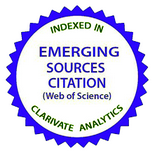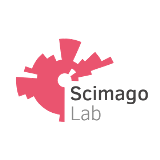Deformation Features in the Cell When the Coronavirus Enters It
DOI:
https://doi.org/10.15407/ujpe66.9.785Keywords:
coronavirus, cell, deformation, penetrationAbstract
A mathematical model has been proposed to describe the deformation behavior of a cell, when a coronavirus enters it. The model is continuum-based, and the theory of elasticity is used in calculations. It was found that the deformation process accompanying the penetration of coronavirus consists of two stages. At the first stage, the deformations of cytoplasmic membrane are elastic. At the second stage, the structure of a cytoplasmic membrane is destroyed. The dependence of the energy of the “coronavirus–cell” system on the size of the contact zone that separates the coronavirus and the cell was obtained. The existence of an energy barrier that separates both stages of the deformation process was proved. As a result, the penetration of the coronavirus terminates at the end of the first stage. However, the energy barrier can be overcome due to thermal fluctuations.
References
V.G. Zarnitsyn, M.R. Prauznits, Yu.A. Chizmadzhev. Physical methods for the transfer of nucleic acids into tissues and cells. Biol. Membr. Zh. Membr. Klet. Biol. 21, 355 (2004) (in Russian).
A.S. Davydov. Biology and Quantum Mechanics (Pergamon Press, 1981).
S. Klein, M. Cortese, S.L. Winter, M. Wachsmuth-Melm, Ch.J. Neufeldt, B. Cerikan, M.L. Stanifer, S. Boulant, R. Bartenschlager, P. Chlanda. SARS-CoV-2 structure and replication characterized by in situ cryo-electron tomography. Nat. Commun. 11, 1 (2020).
https://doi.org/10.1038/s41467-020-19619-7
L.D. Landau, E.M. Lifshitz, Theory of Elasticity (Pergamon Press, 1959).
S.P. Timoshenko. A Course in the Theory of Elasticity (Naukova Dumk1, 1972) (in Russian).
A.B. Jena, N. Kanungo, V. Nayak, G.B.N. Chainy, J. Dandapat. Catechin and Curcumin interact with corona (2019-nCoV/SARS-CoV2) viral S protein and ACE2 of human cell membrane: insights from Computational study and implication for intervention. SCI REP-UK (2021). https://doi.org/10.21203/rs.3.rs-22057/v1
J.B. Junior. Interaction energies of the human ACE2 molecular recognition by SARS-CoV-2. Virol. Curr. Res. 4, 1 (2020).
M.M. Poo, R.A. Cone. Lateral diffusion of rhodopsin in the photoreceptor membrane. Nature 247, 438 (1974). https://doi.org/10.1038/247438a0
R. Skalak. Rheology of red blood cell membrane. Microcirculation 1, 53 (1976).
P.H. Geil. Polymer Single Crystals (Interscience Publishers, 1963) [ISBN: 978-0470295106].
E.M. Lifshitz, L.P. Pitaevsky, Statistical Physics: Theory of the Condensed State (Butterworth-Heinemann, 1980).
L.M. Kachanov. Fundamentals of the Theory of Plasticity (Dover, 2004).
Downloads
Published
How to Cite
Issue
Section
License
Copyright Agreement
License to Publish the Paper
Kyiv, Ukraine
The corresponding author and the co-authors (hereon referred to as the Author(s)) of the paper being submitted to the Ukrainian Journal of Physics (hereon referred to as the Paper) from one side and the Bogolyubov Institute for Theoretical Physics, National Academy of Sciences of Ukraine, represented by its Director (hereon referred to as the Publisher) from the other side have come to the following Agreement:
1. Subject of the Agreement.
The Author(s) grant(s) the Publisher the free non-exclusive right to use the Paper (of scientific, technical, or any other content) according to the terms and conditions defined by this Agreement.
2. The ways of using the Paper.
2.1. The Author(s) grant(s) the Publisher the right to use the Paper as follows.
2.1.1. To publish the Paper in the Ukrainian Journal of Physics (hereon referred to as the Journal) in original language and translated into English (the copy of the Paper approved by the Author(s) and the Publisher and accepted for publication is a constitutive part of this License Agreement).
2.1.2. To edit, adapt, and correct the Paper by approval of the Author(s).
2.1.3. To translate the Paper in the case when the Paper is written in a language different from that adopted in the Journal.
2.2. If the Author(s) has(ve) an intent to use the Paper in any other way, e.g., to publish the translated version of the Paper (except for the case defined by Section 2.1.3 of this Agreement), to post the full Paper or any its part on the web, to publish the Paper in any other editions, to include the Paper or any its part in other collections, anthologies, encyclopaedias, etc., the Author(s) should get a written permission from the Publisher.
3. License territory.
The Author(s) grant(s) the Publisher the right to use the Paper as regulated by sections 2.1.1–2.1.3 of this Agreement on the territory of Ukraine and to distribute the Paper as indispensable part of the Journal on the territory of Ukraine and other countries by means of subscription, sales, and free transfer to a third party.
4. Duration.
4.1. This Agreement is valid starting from the date of signature and acts for the entire period of the existence of the Journal.
5. Loyalty.
5.1. The Author(s) warrant(s) the Publisher that:
– he/she is the true author (co-author) of the Paper;
– copyright on the Paper was not transferred to any other party;
– the Paper has never been published before and will not be published in any other media before it is published by the Publisher (see also section 2.2);
– the Author(s) do(es) not violate any intellectual property right of other parties. If the Paper includes some materials of other parties, except for citations whose length is regulated by the scientific, informational, or critical character of the Paper, the use of such materials is in compliance with the regulations of the international law and the law of Ukraine.
6. Requisites and signatures of the Parties.
Publisher: Bogolyubov Institute for Theoretical Physics, National Academy of Sciences of Ukraine.
Address: Ukraine, Kyiv, Metrolohichna Str. 14-b.
Author: Electronic signature on behalf and with endorsement of all co-authors.

















